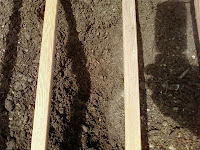"MAAAAAAAYMER!" bellows a voice out the front door like a ship's horn. "Kitten, kitten, kitten," the voice continues. Suddenly a bellow from across the street,"MEEEEEEEEEAOUUUUUU, MEEEEEEEEEAOUUUUUU." A small gray, tailless creature streaks across the quiet neighborhood road, up the front steps and through the front door. It's Mamah, who doesn't want to be left out of whatever is going on. She's been across the street, probably schmoozing her favorite neighbors who've named her Squeaky, obviously after her dramatic, high-pitched squeal she's so generous to express.
 |
| Just a few weeks old |
"Here, take one," the neighbor exclaimed, "they're wrecking my house!"
Upon one look, "Oh, alright," I reluctantly answered, "but I'll only take a female. We have too many male cats that like to mark the house." (Of course, my assumption about female cats would be eventually proven false, as female felines aren't without their complaints. Hell hath no furry like a female cat scorned.)
So, being the sucker that I am, I got the pick from a litter of adorable, evil kittens and selected the only female of the bunch that also happened to be the runt of the litter. All of the tiny fur bundles in this litter were tailless. Mama cat was a tortoise shell and dad happened to be one of several striking Manx I've seen prowling the neighborhood. I wasn't surprised that kittens materialized. People in my neighborhood are all too often adverse or slow to get their animals fixed. So, for what seemed like endless nights of sudden sleep deprivation, I heard multiple coupling events of feline drama under my bedroom window (like an omen). These things always seem to happen under the bedroom window in the middle of the night!
 |
| Mamah and Floyd - double trouble |
Mamah also became attached to Vinnie. Every kitten should have an uncle Vinnie. He put up with her endless harassment and being a big, fluffy boy, she would snuggle into his fur for a nap.
 |
| Mamah with Uncle Vinnie |
In her early weeks, what little tail Mamah had was bent to one side, an indication of cramped quarters among her beefier brothers in the womb. As she matured into a teenager, Mamah's tail evolved into a shape similar to the Pope's nose on a plucked chicken butt; rather tear drop shaped, coming to a defined point like the top of a meringue. We nick-named her chicken butt or turkey butt, but that name eventually evolved like her tail into a more rabbit-like metaphor. Thus, the nickname Bunny-Butt. Being half Manx, her back is shorter than her tailed brethren causing her back end to stick up like a beacon to all of male catdom. She's also a flirt with the boys. We had her fixed as soon as possible, less we end up with 6 more just like her.
Very vocal, she presents a meow that sounds like the damsel in distress on the edge of the building seen in the Edward Gorey introduction to Masterpiece Mystery. And she's very liberal in her vocalizations with a lot of drama in the amplified chortles. She's now one of the gang at Mog Cottage, staying rather runt-like, but her personality more than compensates. Her teenage stage certainly proved eventful.








